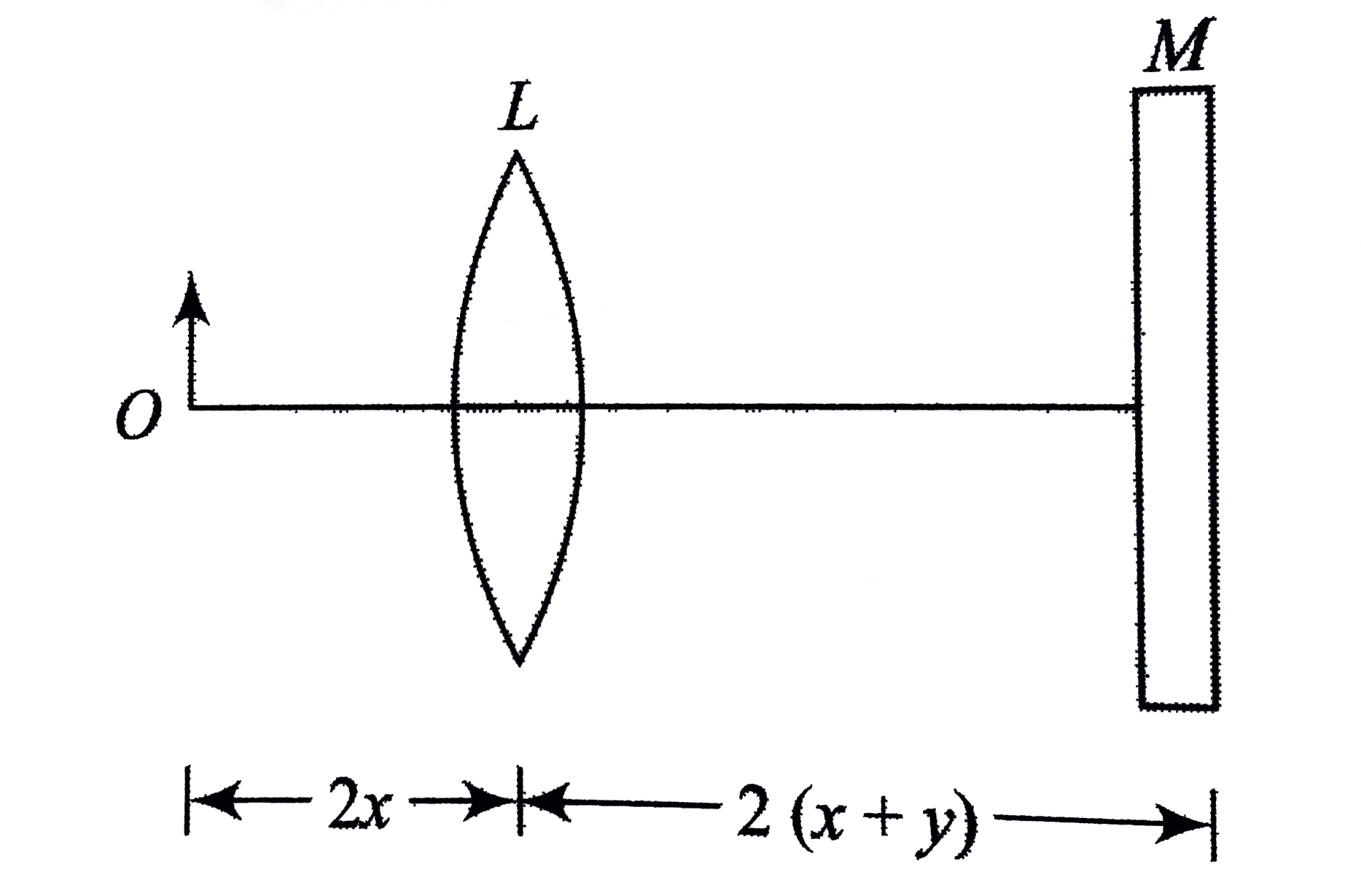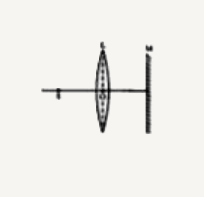L is a lens such that a parallel beam of light I ncident on it, after refraction, converges to a point at a distance x from it and M is a mirror such that a parallel lbeam of light incident on it, after reflection, converges to a point at a distance y from it. Now the lens L and mirror M are placed at a distan 2(x+y) from each other. An object of size 2 cm is kept infront of lens at a distance 2x from it. Find the nature, position , and size of the image that willl be seen by an observer looking toward the mirror through the lens.

It is given that a parallel beam incident on the lens, after refraction, converges to a point at a distance x from the lens. This implies that the focal length of the lens is x.
It is also given that a parallel beam incident on the mirror, after reflectino, converges to a point at a distance y from it. This implies that the mirror is a concave mirror of focal length y.
Obviously, object O is kept at 2F of lens L. Hence, its image I1 forms on the other side oat 2F , i.e., at distance 2x to the right of the lens. The image will be real, inverted, and magnification of this image m1=vu=2x−2x=−1 .
Image I1 of O formed by lens L acts as object for the mirror. Its distance from the pole of mirror will 2(x+y)−2x=2y . This implies that it will be at the center of curvature of the concave mirror (y being the focal length of the mirror). Therefore, the concave mirror forms a real, inverted (relative to I1) image I2 at the same position.
Magnification of I2 (relative to I1 ), m2=−1 . Finally, I2 acts as object for the lens. Its distance from thelens is 2x. Hence, it is at 2F of the lens (x being the focal length of the lens). Therefore, the lens will form a real and inverted image of I2 at 2F on the other side, i.e., to its left. Obviously, I3 will be at the same position as of the object.
Magnification of I3 (relative oto I2)=−1
Total magnification =m1×m2×m3=−1×−1×−1=−1
Thus, the final image is real and inverted and of the same size (2cm).
Complete reay diagram is shown in Figure.


Topper's Solved these Questions
- BOOK - CENGAGE PHYSICS ENGLISHCHAPTER - GEOMETRICAL OPTICSEXERCISE - Solved Examples15videos
GEOMETRICAL OPTICS
- BOOK - CENGAGE PHYSICS ENGLISHCHAPTER - GEOMETRICAL OPTICSEXERCISE - Exercise1.114videos
GEOMETRICAL OPTICS
- BOOK - CENGAGE PHYSICS ENGLISHCHAPTER - ELECTRON,PHONTS,PHOTOELECTRIC EFFECT & X-RAYSEXERCISE - dpp 3.315videos
ELECTRON,PHONTS,PHOTOELECTRIC EFFECT & X-RAYS
- BOOK - CENGAGE PHYSICS ENGLISHCHAPTER - HEATING EFFECT OF CURRENTEXERCISE - Thermal Power in Resistance Connected in Circuit27videos
HEATING EFFECT OF CURRENT
Similar Questions
Find the angle between two plane mirrors such that a ray of light incident on the first mirror and parallel to the second mirror is reflected from the second mirror, parallel to the first mirror.
View SolutionA clear transparent glass sphere (μ=1.5) of radius R is immersed in a liquid of refractive index 1.25. A parallel beam of light incident on it will converge to a point. The distance of this point from the center will be
View Solution
Knowledge Check
- Question 1 - Select One
A ray of light after reflection from a mirror is known as
Areflected rayBnormalCincident rayDrefracted ray
A parallel beam of light is incident on a converging lens parallel to its principal axis. As one moves away from the les on the other side on its principal axis, the intensity of light
View SolutionA convex lens of focal length 1.0m and a concave lens of focal length 0.25m are 0.75m apart. A parallel beam of light is incident on the convex lens. The beam emerging after refraction from both lenses is
View SolutionA thin convex lens of focal length 30cm is placed in front of a plane mirror. An object is placed at a distance x from the lens (not in between lens and mirror ) so that its final image coincides with itself. Then, the value of x is
View SolutionThe diagram shows a point source of light S, a convex lens L and plane mirror M. These are placed such that rays of light from S return to it after reflection from M.

What is the distance OS called?View SolutionA convergent beam of light is incident on a convex mirror so as to converge to a distance 12 cm from the pole of the mirror. An inverted image of the same size is formed coincident with the virtual object. What is the focal length of the mirror ?
View SolutionA point source of light is kept at a distance of 15cm from a converging lens,on its optical axis.The focal length of the lens is 10cm and its diameter is 3cm ,A screen is placed on the other side of the lens ,perpendicular to the axis of lens,at a distance 20cm from it.Then find the area of the illuminated part of the screen?
View SolutionA parallel beam of light, parallel to the principal axis of a concave mirror, on reflection meets at the :
View Solution

